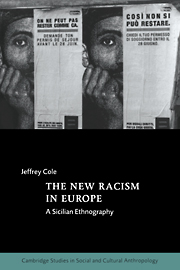Book contents
- Frontmatter
- Contents
- List of illustrations
- Acknowledgments
- Map
- 1 Introduction
- 2 When the bottom looks down: working-class views of immigrants in Palermo
- 3 The view from the top: bourgeois views of immigrants in Palermo
- 4 The politics of race and immigration in the Italian north and south
- 5 Conclusions
- Appendix
- Notes
- References
- Index
- Cambridge Studies in Social and Cultural Anthropology
2 - When the bottom looks down: working-class views of immigrants in Palermo
Published online by Cambridge University Press: 12 October 2009
- Frontmatter
- Contents
- List of illustrations
- Acknowledgments
- Map
- 1 Introduction
- 2 When the bottom looks down: working-class views of immigrants in Palermo
- 3 The view from the top: bourgeois views of immigrants in Palermo
- 4 The politics of race and immigration in the Italian north and south
- 5 Conclusions
- Appendix
- Notes
- References
- Index
- Cambridge Studies in Social and Cultural Anthropology
Summary
The question of working-class racism
This chapter examines the form, content, and extent of racism and other reactions towards Africans and Asians among working Palermitans. Observers agree that, of all groups, European workers reveal the most hostility towards immigrants (Balibar 1991c, 1991e; Castles and Kosack 1985; Husbands 1983; Reeves 1983; Van Dijk 1987; Wieviorka 1992). Trade union representatives, for example, regularly find themselves caught between their aspirations to international solidarity of labor and the protectionist and nationalist demands of their indigenous members (Castles 1984; Grillo 1985). Yet little direct research on the problem has been carried out because most scholars, concentrating on the benefits to capitalists of a racially divided labor force, have too often reduced race to class and overlooked or dismissed the possiblity of racism from below (Roediger 1991: 6–11). However, the few studies to have investigated the ways in which class shapes views on immigrants and essentialist ideologies suggest valuable lines of inquiry.
In their study of a London neighborhood, Annie Phizacklea and Robert Miles (1979, 1980) argue that “working-class racism” derives not so much from adherence to ideologies of racial inequality as from the daily experience of competing with immigrants for jobs and public housing. For the English workers, the visible “coloureds” thus appear as the cause of what are in fact broader trends of industrial decline and rising unemployment. This “racist explanation for material disadvantage and decline,” it is important to note, “is only one of a number of explanations which are often as vague and inconsistent as the former” (Phizacklea and Miles 1980: 176).
- Type
- Chapter
- Information
- The New Racism in EuropeA Sicilian Ethnography, pp. 25 - 73Publisher: Cambridge University PressPrint publication year: 1997



